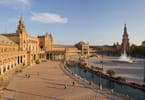The first tolls of the 2025 Jubilee na Rom were heard as the city is in a full COVID-19 emergency. Palazzo Chigi, the seat of the Rome Government, hosted a meeting between Prime Minister Giuseppe Conte; the Regional Governor, Nicola Zingaretti; and Msgr. Rino Fisichella, President of the Pontifical Council, for the promotion of the new evangelization for the first thoughts on the next Holy Year in 2025.
There is talk of a joint commission between the Italian State and the Vatican which seems to be a prelude to the establishment of a Jubilee Agency as it happened in 2000. The plan is being made in such advance knowing the times of our bureaucracy.
The event will be an extraordinary opportunity, not only for Rome to redesign an economic, urban, and social development plan that will in any case have to deal with the pandemic, but also the election of a new mayor and an effective operational plan to optimize the funds made available by Europe.
Holy Year: The Jubilees of the Church from Pope Leo XIII to Francis
The origins of the Jubilee date back to the Old Testament. In fact, the word “jubilee” derives from Jubilaeum which derives from the three Hebrew words Jobel (ram), Jobil (call), and Jobal (remission). In chapter XXV of Leviticus, the Jewish people sound the horn (Jobel) every 49 years to call (Jobil) the people of the entire country, declaring the fiftieth year holy and proclaiming the remission (Jobal) of all. According to the Old Testament, the Jubilee brought with it general liberation from a condition of misery, suffering, and marginalization.
Twenty-five Jubilees have been celebrated to date, the year 2000 being the twenty-sixth. Boniface VIII announced the first Jubilee in 1300 and decided that they would celebrate it every hundred years. Clement VI in 1342 called it every 50 years, while Urban VI in 1389 (1390) decided that they would celebrate it every 33 years. In 1470, Paul II determined the expiration of the Holy Year every 25 years, because of the shortness of human life and human weakness towards sin. Some Popes have even proclaimed extraordinary Holy Years outside this deadline.
In more recent times, Pope Benedict XVI proclaimed the Pauline Year, a special jubilee year from June 28, 2008 to June 29, 2009, dedicated to the apostle Paul of Tarsus on the occasion of the two-thousandth anniversary of the saint’s birth (placed by historians between 7 and 10 AD).
On March 13, 2015, Pope Francis announced an extraordinary Jubilee 50 years after the Second Vatican Council, starting on December 8, 2015 and ending on November 20, 2016.
The twentieth century is the era in which the Church held more Jubilees – between ordinary and extraordinary – than in any other century: 8 between 1900 and 2000: 1925, 1933, 1950, 1966, 1975, 1983, and 2000.
On the occasion of the Holy Year of Mercy 2016 inaugurated by Pope Francis, the Cassa di Risparmio di Perugia Foundation and the Carioperugia Arte Foundation organized the exhibition “Holy Year.” The Jubilees of the Church from Leo XIII to Francis documents these jubilee events both from a more strictly theological-religious and historical point of view and for the social, political, and cultural effects produced in the societies of the time.
The Extraordinary Jubilee of Mercy was proclaimed by Pope Francis through the papal bull Misericordiae Vultus. Previously announced by the same pontiff on March 13, 2015, it began on December 8, 2015 and ended on November 20, 2016.
The Participation of the Faithful in the Last Jubilee of Mercy of 2015/16
Global participation reported that in the countries where Catholicism is more rooted, the portion of the faithful who have vacated the Holy Doors exceeded 80 percent of believers. Worldwide, average participation is estimated to be between 56 and 62 percent of the overall Catholic population.
The faithful who after December 8, 2015 have crossed the Holy Door only in cathedrals and other diocesan churches range between 700 and 850 million. To them are added those who flocked to shrines and pilgrimage sites: there were 5 million in Krakow, 22 million in Guadalupe, while Santiago de Compostela exceeded the record of 272,000 recorded in 2010. These numbers from which the overall estimate is 950 million, has matured of faithful that have passed through the gates of the whole world.
The last ordinary Holy Year was the Great Jubilee of 2000, while the next will be in 2025.
#mmegharị njem
IHE Ị GA-Ewepụ na edemede a:
- The event will be an extraordinary opportunity, not only for Rome to redesign an economic, urban, and social development plan that will in any case have to deal with the pandemic, but also the election of a new mayor and an effective operational plan to optimize the funds made available by Europe.
- In more recent times, Pope Benedict XVI proclaimed the Pauline Year, a special jubilee year from June 28, 2008 to June 29, 2009, dedicated to the apostle Paul of Tarsus on the occasion of the two-thousandth anniversary of the saint’s birth (placed by historians between 7 and 10 AD).
- There is talk of a joint commission between the Italian State and the Vatican which seems to be a prelude to the establishment of a Jubilee Agency as it happened in 2000.






















